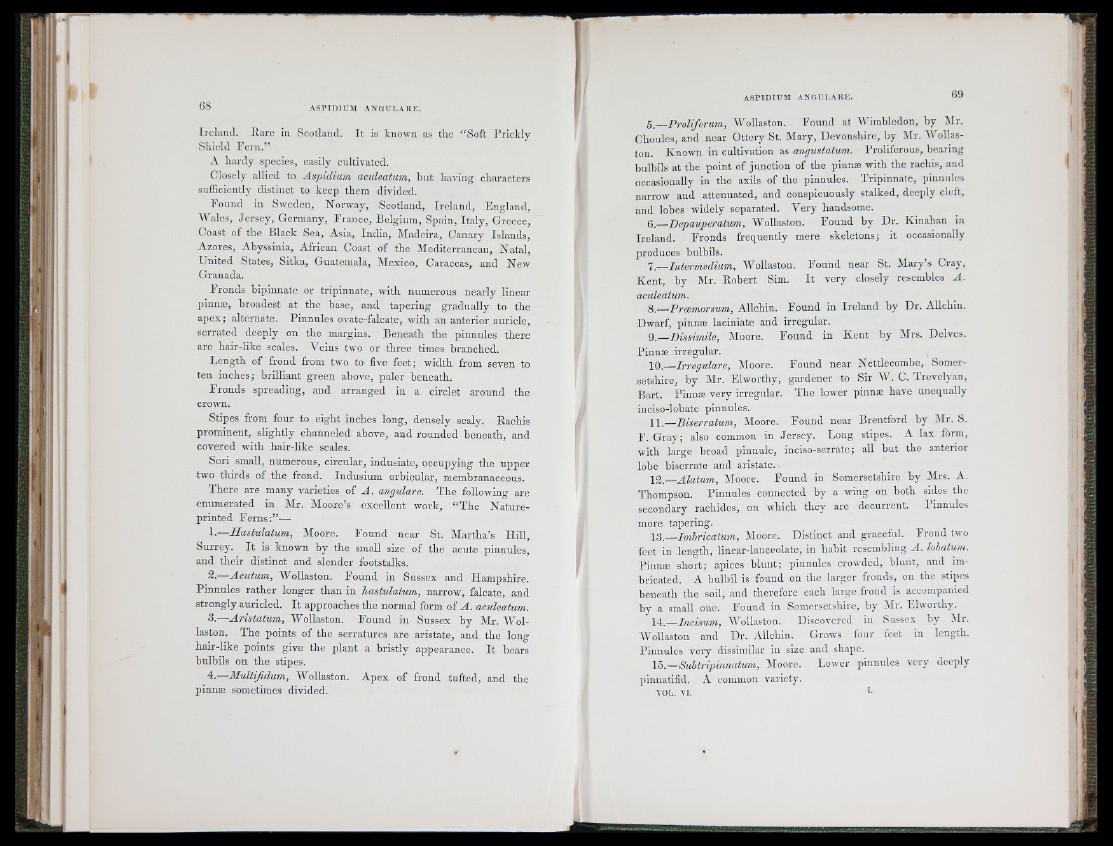
()8 A S I’TD IUM A N G U L A U E .
Troland. Rave in Scotland. I t is known as the “ Soft Prickly
Shield Pe rn .”
A hardy species, easily cultivated.
Closely allied to Aspidium aculeatum, bnt having characters
sufficiently distinct to keep them divided.
Found in Sweden, Norway, Scotland, Ireland, England,
Wales, Jersey, Germany, France, Belgium, Spain, Italy, Greece,
Coast of the Black Sea, Asia, India, Madeira, Canary Islands,
Azores, Abyssinia, African Coast of the Mediterranean, Natal,
United States, Sitka, Guatemala, Mexico, Caraccas, and New
Granada.
Fronds bipinnate or tripinnate, with numerous nearly linear
pinnæ, broadest at the base, and tapering gradually to the
apex; alternate. Pinnules ovate-falcate, with an anterior auricle,
serrated deeply on the margins. Beneath the pinnules there
are hair-like scales. Veins two or three times branched.
Length of frond from two to five feet; width from seven to
ten inches; brilliant green above, paler beneath.
Fronds spreading, and arranged in a circlet around the
crovra.
Stipes from four to eight inches long, densely scaly. Rachis
prominent, slightly channeled above, and rounded beneath, and
covered with hair-like scales.
Sori small, numerous, circular, indusiatc, occupying the upper
two thirds of the frond. Indusium orbicular, membranaceous.
There are many varieties of A . angulare. The following are
enumerated in Mr. Moore’s excellent work, “ The Nature-
printed F e rn s:”—
Hastulatum, Moore. Found near St. Martha’s H ill,
Surrey. I t is known by the small size of the acute pinnules,
and their distinct aud slender footstalks.
—Acutum, Wollaston. Found in Sussex and Hampshire.
Pinnules rather longer than in hastulatum, narrow, falcate, and
strongly auricled. I t approaches the normal form of A . aculeatum.
3.—Aristatum, Wollaston. Found in Sussex by Mr. Wollaston.
The points of the serratures are aristate, and the long
hair-like points give the plant a bristly appearance. I t bears
bulbils on the stipes.
4.—-Multifidum, Wollaston. Apex of frond tufted, and the
pinnæ sometimes divided.
b.— Froliferum, Wollaston. Found at MBrnblcdon, by Mr.
Choulcs, and near Ottery St. Mary, Devonshire, by Mr. 'Wollaston.
Known in cultivation as anejustatum. Proliferous, bearing
bulbils at the point of junction of the pinnæ with the rachis, and
occasionally in the axils of the pinnules. Tripinnate, pinnules
narrow and attenuated, and conspicuously stalked, deeply cleft,
and lobes widely separated. Very handsome.
6.—Bepauperatum, Wollaston. Found by Dr. Klnahan in
Ireland. Fronds frequently mere skeletons; it occasionally
produces bulbils.
1 .—-Intermedium, Wollaston. Found near St. Mary’s Cray,
Kent, by Mr. Robert Sim. I t very closely resembles A .
aculeatum.
8.—Proemorsum, Allchin. Found in Ireland by Dr. Allchin.
Dwarf, pinnæ laciniate and irregular.
Q.— Dissimile, Moore. Found in Kent by Mrs. Delves.
Pinnæ irregular.
\Q.— Irreguläre, Moore. Found near Nettlecombe, Somersetshire,
by Mr. Elworthy, gardener to Sir W. C. Trevelyan,
Bart. Pinnæ very irregular. The lower pinnæ have unequally
inciso-lobate pinnules.
\ \ .—Biserratum, Moore. Found near Brentford by Mr. S.
F. Gray; also common in Jersey. Long stipes. A lax form,
with large broad pinnule, inciso-serrate ; all but the anterior
lobe biserrate and aristate.
12 . Alatum, Moore. Found in Somersetshire by Mrs. A.
Thompson. Pinnules connected by a wing on both sides the
secondary rachides, on which they are decurrent. 1 innules
more tapering.
13.—Imbricatum, Moore. Distinct and graceful. Frond two
feet in length, linear-lanceolate, in habit resembling A . lohatum.
Pinnæ short; apices blunt; pinnules crowded, blunt, and imbricated.
A bulbil is found on the larger fronds, on the stipes
beneath the soil, and therefore each large frond is accompanied
by a small one. Found in Somersetshire, by Mr. Elworthy.
W — Incisum, Wollaston. Discovered in Sussex by (Mr.
Wollaston and Dr. Allchin. Grows four feet in length.
Pinnules very dissimilar in size aud shape.
15.—Siihtripinnatum, (Moore. Lower pinnules very deeply
pinnatifid. A common variety.
VOL. VI.